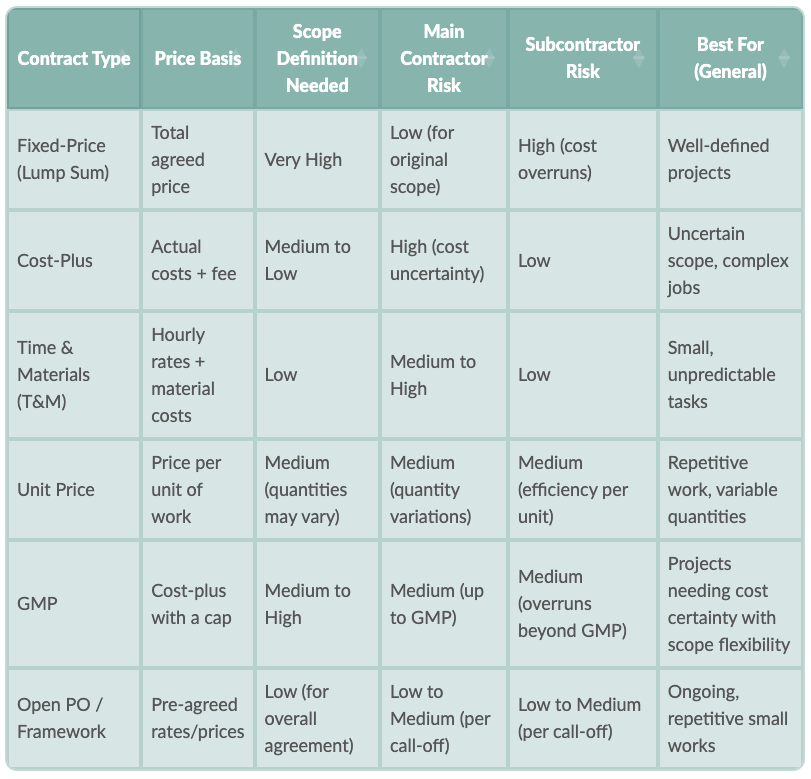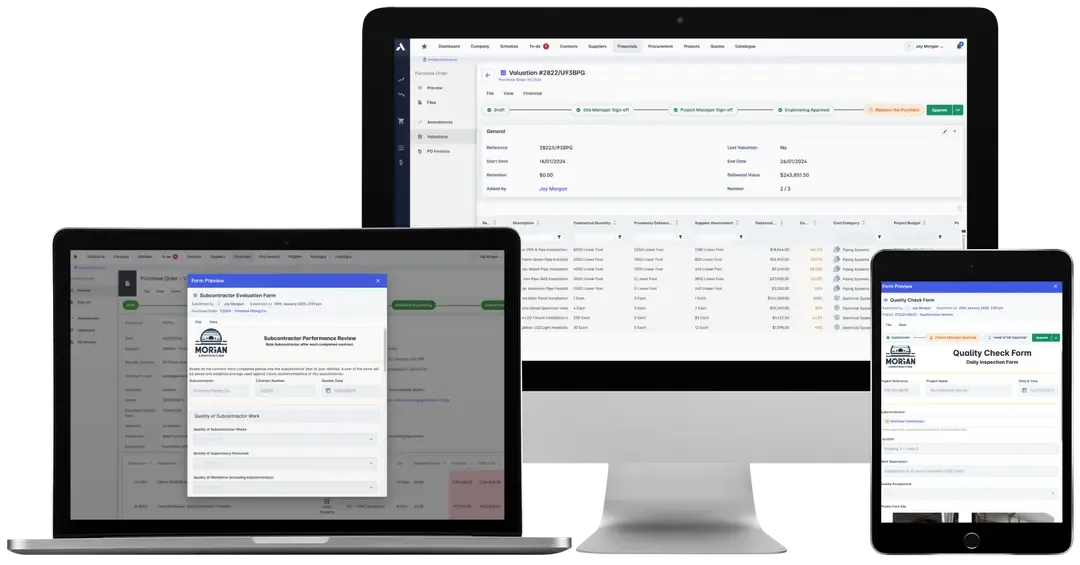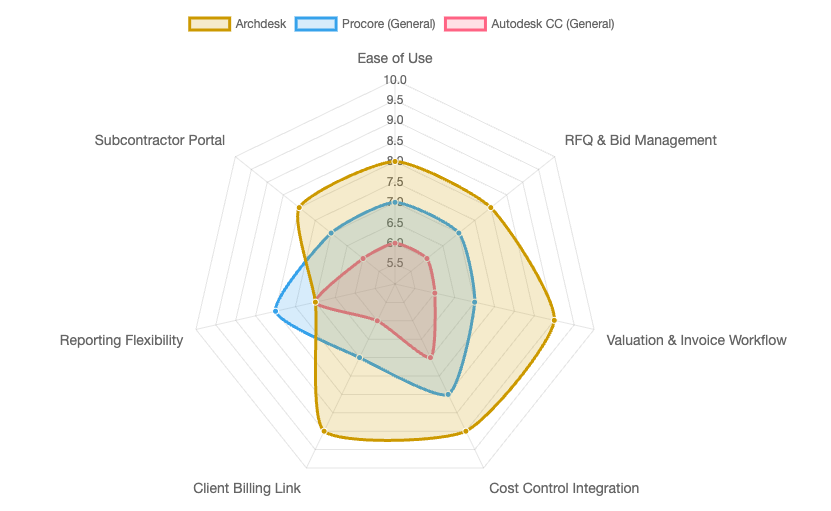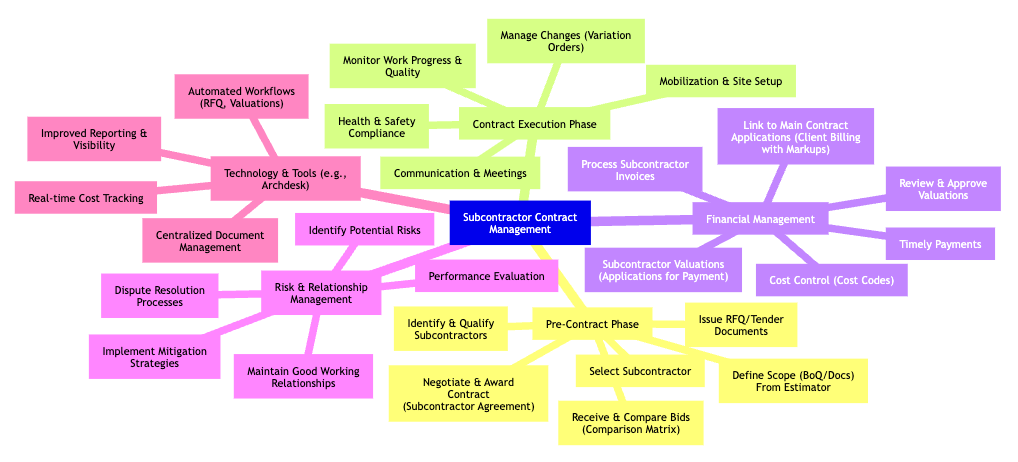Quick Wins: What You Absolutely Need to Know
- Nail the Paperwork: Getting the right type of contract from the get-go (Lump Sum, Cost-Plus, T&M, etc.) is half the battle. It means everyone knows what they’re doing and what they’re getting paid.
- The Process is Your Pal: From a clear Bill of Quantities (BoQ), to a sharp Request for Quotation (RFQ) process and smart bid comparisons, sticking to a system keeps things fair and cuts down on headaches.
- Smart Tech, Smarter Work: Using tools like Archdesk isn't just fancy – it’s about making your life easier by connecting all the dots, from the initial scope to final payment and keeping costs in check.
First Things First: What's a Subcontractor Anyway?
Alright, let's get down to brass tacks. A subcontractor, or "subbie" as we often call 'em, is a specialist hired by the main contractor (that's probably you) to do a specific chunk of the work on a construction project. You wouldn't get your brickie to do the wiring, would you? Nope. You hire an electrician for that. That electrician is your subbie for the electrical work. They're the experts in their particular trade, bringing skills you might not have in your own crew.
You'll find a whole army of different subbies on any decent-sized job. Think about:
- HVAC (Heating, Ventilation, and Air Conditioning): These are the folks making sure the building breathes right and stays comfy.
- Plumbers: Getting water in and out, fitting pipes, sinks, toilets – the wet stuff.
- Electricians: All things wires, lights, sockets, and making sure the power flows safely.
- Masons: Laying bricks, blocks, and stone. The solid backbone of many structures.
- Carpenters: From framing to finishing touches like doors and cabinets.
- Roofers: Keeping the rain and weather out from above.
- Concrete Specialists: Pouring foundations, slabs, and anything that needs to be super strong.
- Painters: Making it all look sharp, inside and out.
- Landscapers: The green-fingered crew dealing with the outside – grass, plants, paths.
- And many more, like demolition experts, steel erectors, glaziers, and excavators.
These specialists are vital. Without them, most big projects just wouldn't get finished. Managing the agreements you make with them – that's subcontractor contract management.
Why Bother With All This Contract Stuff?
So, you've got your team of specialist subbies. Why the fuss about contracts? Can't you just shake hands? Well, you could, but that's a recipe for disaster on anything bigger than a garden shed. A proper contract is a legally binding document. It clearly lays out who's doing what, when they're doing it, how much they're getting paid, and who's responsible if things go sideways. Getting this right is crucial because:
- Clarity on Scope: Everyone knows exactly what work the subbie is responsible for. No arguments later about "that wasn't in my price!"
- Money Talks: The contract locks in the price and payment terms. This is massive for your budget and for the subbie to run their business.
- Keeping Time: Contracts usually include schedules. This helps keep the whole project on the rails and delivered on time.
- Covering Your Backside: It deals with risk. If something goes wrong, the contract should say who foots the bill or fixes the problem. This can save you massive legal headaches.
- Quality Control: Often, the contract specifies the standard of work expected.
In short, good subcontractor contract management keeps your project on budget, on schedule, and out of the courtroom.
Different Deals for Different Jobs: Common Contract Types
Just like you use different tools for different tasks, there are different types of contracts for subbies. The best one depends on the job, how much you know upfront, and who's carrying the most risk. You'll see these in both the US and the UK, though sometimes with different names or standard forms (like JCT or NEC in the UK, and AIA forms often used in the US).
Fixed-Price (Lump-Sum) Contracts
This is often the simplest. You and the subbie agree on a total price for their entire scope of work before they start. They do the job, you pay the agreed amount. Done.
- US Example: You're building a standard retail unit in Texas. You get a lump-sum quote of $75,000 from an HVAC subcontractor to install the entire system as per the drawings.
- UK Example: For a new housing development in Manchester, a JCT Minor Works Sub-Contract might be used with a painting subcontractor for a fixed price of £5,000 per house.
- Good for: Projects where the scope is super clear from day one. The main contractor knows their costs upfront.
- Risks: If the scope wasn't clear or changes, you'll be looking at variation costs. The subbie carries the risk if their costs run higher than anticipated.
Cost-Plus Contracts
Here, you agree to pay the subcontractor for their actual costs (labour, materials, equipment hire) plus an agreed-on fee or percentage for their overhead and profit. Transparency is key here.
- US Example: A complex renovation of a historic building in Boston where unforeseen issues are likely. The electrical sub works on a cost-plus 15% basis. All their invoices for materials and timesheets are submitted for reimbursement plus the agreed margin.
- UK Example: Emergency repair work after a flood on a commercial property in London. A plumbing sub might use an NEC3 Engineering and Construction Short Subcontract on a cost-reimbursable (cost-plus) basis to get the systems back online quickly.
- Good for: When the scope is uncertain or likely to change. The subbie is covered for their costs.
- Risks: The final cost isn't known upfront, which can be scary for the main contractor. Often paired with a Guaranteed Maximum Price (GMP) to cap the exposure.
Time and Materials (T&M) Contracts
Similar to cost-plus, but often simpler and used for smaller, unpredictable jobs. You pay agreed hourly rates for labour and the actual cost of materials, sometimes with a small markup on materials.
- US Example: Minor fit-out changes in an existing office in Chicago. A carpentry sub is hired at $85/hour plus materials at cost for a few days' work.
- UK Example: A small landscaping job on a residential project where the exact hours are unknown. The landscaper charges £40/hour plus the cost of plants.
- Good for: Small jobs, repair work, or when you really don't know how long something will take.
- Risks: Costs can escalate if not monitored closely. A "not-to-exceed" cap is a good idea.
Unit Price Contracts
The project is broken down into measurable units of work (e.g., per cubic metre of concrete, per linear metre of pipe, per item installed). You agree on a price for each unit. The total payment is based on the quantity of units actually completed.
- US Example: Laying data cables in a large new office building in Silicon Valley. The low-voltage subcontractor quotes $150 per data point installed.
- UK Example: Earthworks on a new road project. The groundworks subcontractor prices per cubic metre of material excavated and per tonne of aggregate laid, often using a schedule of rates aligned with an NEC contract.
- Good for: Projects where the type of work is clear, but the exact quantities aren't known until work is underway. Common in civil engineering.
- Risks: The total cost can vary significantly if the estimated quantities are way off. Requires accurate measurement of completed work.
Guaranteed Maximum Price (GMP) Contracts
Often an addition to a cost-plus contract. The subcontractor agrees that the total cost (their costs plus fee) will not exceed a certain amount (the GMP). If it costs less, savings might be shared. If it costs more, the subbie often eats the difference.
- US Example: A design-assist mechanical subcontract for a new hospital wing in Florida might have a GMP of $5 million. The sub provides open-book accounting of their costs.
- UK Example: A complex curtain walling package on a high-rise in Birmingham might use a bespoke subcontract with a GMP element to provide the client with cost certainty while allowing design development.
- Good for: Gives the main contractor cost certainty while still having the flexibility of a cost-plus arrangement for scope development.
- Risks: The subbie takes on the risk of overruns beyond the GMP, so they'll price that risk in. Defining what's in and out of the GMP is critical.
Open Purchase Order (Open PO) / Framework Agreement
Not always a full-blown contract for a specific project, but an agreement that sets out terms and prices for ongoing or repetitive work over a period. Specific jobs are then "called off" this agreement.
- US Example: A facilities management company has an Open PO with an electrical subcontractor for routine maintenance and minor repairs across multiple sites, with pre-agreed hourly rates and material markups.
- UK Example: A housing association has a Framework Agreement with several plumbing and heating contractors for boiler servicing and responsive repairs across their housing stock. Individual jobs are issued as work orders against the framework.
- Good for: Regular, smaller jobs with known suppliers. Saves time on re-tendering for every little thing.
- Risks: Less detailed scope for individual jobs, so careful management of each call-off is needed.
Here's a simple table to help you see the main differences at a glance:

The Nuts and Bolts: From Scope to Signed Deal
So, how do you actually get a subbie signed up? It's a step-by-step process, not just picking a name out of a hat.
1. Getting the Scope Right (The BoQ Connection)
It usually starts with your estimator. They put together a Scope of Work document, often based on a detailed Bill of Quantities (BoQ) or project specifications. The BoQ is basically a shopping list detailing every item, material, and piece of work needed, with quantities. For example, "Supply and install 250m² of 12.5mm plasterboard, skim finish." This clarity is gold.
2. Sending out the Bat-Signal: RFQs and Bidding
Once you know what you need, you send out a Request for Quotation (RFQ) – sometimes just called going out to tender or bidding. You'll send the Scope of Work/BoQ and any relevant drawings or specs to a list of approved and qualified subcontractors. You're asking them to tell you how much they'll charge to do that specific package of work.
3. Sizing Them Up: The Comparison Matrix
When the quotes come flooding back (or trickling, depending on the market!), you need a way to compare them properly. A good procurement specialist creates a comparison matrix. This isn't just about the bottom-line price. You'll compare bids on:
- Price (obviously)
- Completeness (did they price everything?)
- Proposed schedule and lead times
- Experience and references
- Any exclusions or qualifications they've noted
- Their understanding of the job
Lining it all up side-by-side helps you see who’s offering the best overall value, not just the cheapest price that might come with hidden problems.
4. Picking the Winner and Inking the Deal
Based on your comparison, you select the subcontractor who's the best fit. Then it's time to issue the formal Subcontractor Agreement. This will be based on their winning bid and any negotiations you've had. Both sides sign on the dotted line, and you've got a legally binding contract.
Show Me the Money: Valuations and Payments
Once the subbie is on site and cracking on, you need a way to pay them for work done. It's rarely one lump sum at the end (unless it's a tiny job).
Subcontractor's Valuation Reports (Applications for Payment)
Periodically (usually monthly), the subcontractor will submit a valuation report. In the US, this is often called an Application for Payment. It's a detailed breakdown of the work they've completed during that period and how much it's worth according to the contract (e.g., percentage of lump sum items completed, or quantity of unit price items installed).
Checking Their Homework: Approving the Valuation
You, or your quantity surveyor/project manager, will review this valuation. You'll check if the work claimed has actually been done, if it's up to standard, and if the values line up with the contract. You might approve the full amount, or you might adjust it if some work isn't quite there yet.
Invoice In, Cash Out
Once the valuation is approved, the subcontractor issues a formal invoice for that approved amount. Your accounts team then processes this for payment according to the terms in the contract (e.g., 30 days). Paying subbies on time is massively important for keeping good relationships and avoiding disputes.
Your Turn: Billing the Main Client
The work your subbie has done is part of the bigger project you're delivering for your client (the building owner or developer). You'll take all the approved subcontractor valuations for that period, add your own costs (your labour, materials you supplied, site overheads), and then add your markup (your profit and company overhead). All this gets bundled into your main Application for Payment that you submit to your client.
Dodging Bullets: Typical Risks and Red Flags
Managing subbies isn't always a walk in the park. Here are some common pitfalls:
- Rubbish Work: Subbie cuts corners, work isn't up to scratch. Look for: Regular site inspections are a must. Don't just wait till they say they're finished.
- Running Late: Subbie doesn't hit deadlines, holding up everyone else. Look for: Clear schedules in the contract. Monitor their progress like a hawk.
- Costs Spiralling: Especially with Cost-Plus or T&M, if not watched, costs can go through the roof. Look for: Well-defined scope for fixed price. For others, consider GMPs and check every invoice.
- Scope Creep: "Oh, while you're at it, can you just...?" If it's not in the contract, it needs a formal change order, agreed and priced.
- Safety Nightmares: Subbie ignores safety rules. Look for: Check their safety record beforehand. Make your site safety plan crystal clear.
- Money Troubles: Subbie goes bust or can't pay their suppliers. Look for: Do some due diligence. Ask for proof of insurance and bonding if it's a big contract.
- Talking Past Each Other: Poor communication leads to mistakes. Look for: Regular site meetings. Document key decisions.
Tips from the Trenches: Best Practices for Procurement Pros
If you're the one getting subbies on board, here’s some advice to make life smoother:
- Know What You Need: Crystal clear scope before you even think about asking for prices.
- Pick Your Players Wisely (Qualify Subbies): Don't just go for the cheapest. Check their track record, finances, insurance, and if they're actually capable of doing the job.
- Shop Around (Multiple Bids): Always get a few quotes. It keeps everyone competitive.
- Watertight Contracts: Use clear, comprehensive contracts. Define everything: scope, price, payment, schedule, responsibilities, insurance, safety, how to handle disputes. Standard forms (JCT, NEC, AIA) can be a good starting point.
- Manage, Don't Just File: Signing the contract is the start. Monitor progress, review valuations promptly, pay on time, and deal with issues as they pop up.
- Talk, Talk, Talk: Keep the communication lines open. Answer questions. Solve problems together.
- Paper Trail is King: Document everything – contract, changes, valuations, invoices, meeting notes, photos. If it goes wrong, you'll be glad you did.
- Pay Promptly: Seriously, this is huge. Happy subbies are good subbies.
- Changes Done Proper: Any change to the scope needs a formal, written, priced, and signed change order. No "he said, she said."
- Scorecard After the Game: Once it's all done, review how the subbie performed. Good for deciding who to use next time.
Enter Technology: How Software Like Archdesk Helps

Trying to manage all this with spreadsheets, emails, and bits of paper is asking for trouble, especially on bigger jobs. This is where construction management software, like Archdesk, steps in to actually help, not just add another layer of clicks.
Think about that whole process we just talked about:
- Scope from Estimator: In Archdesk, the estimator can load the scope of work and BoQ. This becomes the baseline.
- RFQs & Bidding: You can issue RFQs directly from Archdesk to your approved list of subcontractors. Their bids come back into the system, making that comparison matrix much easier to build and analyze.
- Subcontracting the Works: Once you pick your winner, Archdesk helps generate the subcontract agreement, linking it back to the original scope and their bid.
- Valuations & Invoices: Subcontractors can submit their valuation reports/applications for payment through Archdesk. You review and approve them in the system. When a valuation is approved, the system is ready to receive their invoice against that approved amount. It cuts out a ton of back-and-forth emails and lost attachments.
- Data Flow & Client Billing: This is where it gets really smart. All that approved subcontractor cost data flows back to the original scope items in Archdesk. You can then easily add your markups and generate your application for payment to the end client, knowing all your subbie costs are accurately captured.
- Cost Controlling with Cost Codes: Every item in the BoQ, and therefore in the subcontract, can be assigned a cost code in Archdesk. When you approve a subbie's valuation, those costs are automatically allocated against the right budget codes. This gives you real-time visibility of actual costs versus budget for every part of the job. If plumbing is trending over budget, you'll see it early, not when it's too late.
This kind of integrated system saves a massive amount of time, reduces errors from re-typing info, and gives you a much tighter grip on your project finances and subcontractor performance.
Archdesk vs. The Rest: A Quick Look
There's other software out there, sure – Procore, Autodesk Construction Cloud, Aconex, Buildertrend, Viewpoint. Many do some of these things. But where a system like Archdesk aims to really nail it for builders is by keeping the whole financial workflow connected, from initial estimate and subbie contracts right through to client billing and cost control, without making it feel like you need a PhD to use it. The focus is on a practical, end-to-end solution that understands how construction projects actually run, especially when it comes to managing the money side of subcontracts.
For example, while some systems might be great for document control or field reporting, Archdesk puts a lot of emphasis on making sure the financial tracking of subcontracts is seamless and directly feeds into your main project cost control and client applications. It's about joining up the dots that often get missed between different software packages or manual processes.
This chart gives an idea of how different platforms might stack up based on features crucial for subcontractor management. The scores reflect a general, opinion-based comparison focusing on practical benefits for a construction business managing subcontractors effectively, particularly in integrating financial workflows.

Mapping it Out: The Subcontractor Management Journey
To help visualize the whole shebang, here's a mindmap showing the key stages and considerations in managing your subcontractor contracts. It brings together the different pieces we've talked about, from getting the initial scope to making sure everyone gets paid and the job stays on track.

This mindmap illustrates the interconnected stages of subcontractor contract management, highlighting how each step contributes to the overall success of a project.
It's Not Just Paper: Build Good Relationships
Lastly, remember that while contracts, processes, and software are vital, construction is still a people business. Treating your subbies fairly, communicating clearly, and, yes, paying them on time, goes a hell of a long way. Good subcontractors are worth their weight in gold. They're partners in getting the job done. Effective contract management is a massive part of keeping those partnerships strong and healthy, which means smoother projects for everyone.
Frequently Asked Questions (FAQs)
What's the biggest mistake people make with subcontractor contracts?
One of the biggest is having a vague scope of work. If it's not crystal clear who's doing what, you're asking for arguments, delays, and unexpected costs. Another common one is not having a formal change order process – those "can you just quickly..." requests can kill your budget if they're not documented and priced.
How different are US and UK construction contracts really?
The basic principles (fixed price, cost-plus, etc.) are similar. The main differences often lie in the standard forms used (like JCT/NEC in the UK, AIA in the US), legal terminology, and how disputes are typically handled. For example, the UK has statutory adjudication for payment disputes. Always get local advice if you're unsure.
What's a Bill of Quantities (BoQ) and why is it important for subcontracts?
A Bill of Quantities (BoQ) is a detailed list of all the work items and materials needed for a project, along with their quantities (e.g., 100 square meters of plastering, 50 linear meters of pipework). For subcontracts, it forms a clear basis for pricing. The subcontractor prices against these specific items and quantities. This makes bids easier to compare ("apples for apples") and provides a clear framework for valuing work done during interim payments.
How can software like Archdesk really help with cost control on subcontracts?
Good software links everything together. In Archdesk, for instance, when you set up a subcontract, its value is tied to specific cost codes in your project budget. As you approve valuations and invoices for that subcontractor, the actual spending is automatically recorded against those cost codes. This means you get real-time reports showing budgeted cost vs. actual cost for each part of the job. If a subcontract is trending over budget, you see it immediately and can take action, rather than finding out when it's too late.





